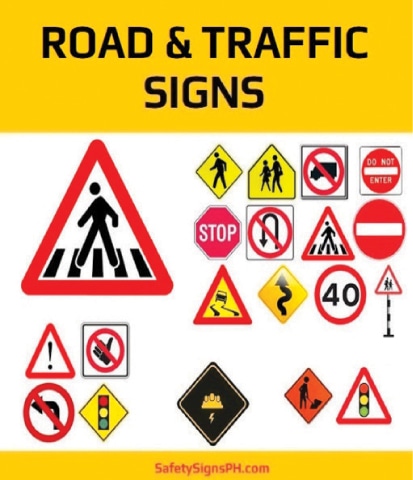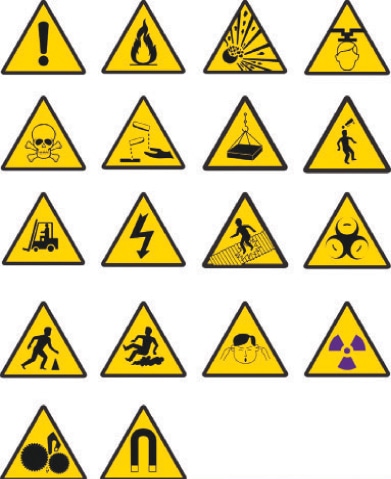
Think for a while. You are visiting a country you have never been to before and you do not know its language, and the people there hardly speak English, let alone your national or any of your regional languages. How are you going to find your way around?
You have two options: one is to use gestures, which is not always feasible nor convenient. The other option is to look for signboards with familiar signs denoting hotels, restaurants, malls, taxi stands, etc. If you are familiar with these signs, your problem is, to an extent, solved. At least you can navigate your way by looking for these signs on the city map, which is, of course, the one thing which you must acquire after landing in a new place.
But signs are not always needed when in a foreign land; you also need them within your city — to find your friend’s house, to look for the outlet of your favourite burger or pizza, to look for a shop in the market, plus a lot more.

The use of signs and symbols to communicate a message is known as signage and is generally defined as “any kind of visual graphic display intended to convey information”, in forms ranging from banners and billboards to street signs and street names. Typically, they tend to serve a few common purposes: to promote goods and services, identify, provide information, give directions, or raise safety awareness.
Signs have become an essential part of our lives. Signs may be used outdoors to help identify the place or within the premises to encourage people to explore the place, such as a museum or a tourist attraction, or to indicate different departments, prayer rooms, and restrooms at a major mall or hospital. They are also used to indicate speed limits on major roads or directions to nearby places.
How did signage come about?

Most of us think signage to be a recent thing, though, in reality, signs have always been a huge part of human communication. In fact, signs have been around since human beings first began expressing themselves by drawing in caves — that is during the Palaeolithic age, which dates back to 18,000BC — where signs were not only used to communicate, but were also ritualistic and spiritual in their essence.
However, modern visual signage started around the time of the Greeks and Romans, dating from about 3000BC, and was a fundamental element in trade. Most of the signs at that time were made of stone or terracotta, made through carvings or paintings on the walls of buildings and used imagery more than text, since many people were illiterate during that time. The purpose of these signs was to identify businesses, such as inns and workshops.
Over time, with the increase in trade and commerce, the need for signs grew dramatically, while an increase in wealth gave way to more elaborate and artistic forms of trade signs. Bright paint, ornamental iron and even gilding began to be used as a means of creating elaborate signs. They also began to grow bigger.

As more people moved to cities and cities began to get crowded with people, street vendors and carts, signs became a danger as they were often hung on to the roads from atop buildings. Realising the danger, ordinances were put in place to control their size and location. During the 1700s, in London and Paris, sign regulations were introduced to protect the public from large signs hanging too far into the narrow streets; signs were to be removed or fixed flat against the wall.
The 18th century saw more advancement in the signage industry; the development of new technologies such as gaslighting, industrial printing press and electricity began to shape the modern idea of signage. With more options available, businesses and artisans began to be creative with signs to attract customers.
During the 1960s, the use of neon lighting became a popular feature in signage due to its attention-grabbing glow. Diners and motels, especially in the USA, began to use neon signs almost exclusively, and the highways were lit up with neon signs. With time, neon signs became much more accessible and affordable for small businesses as their popularity grew.

With the availability of various printable materials, colours, sizes and new technologies, signage has come a long way and it’s going to continue growing and is still used as an effective way of communication.
Types and functions
Direction/Navigation: The signs showing the location of services, facilities, functional spaces and key areas through signposts or directional arrows are known as direction signs. They are necessary for vast locations such as shopping malls, hospitals, airports, museums and tourist attractions.

For instance, if you are at a shopping mall or a hospital and want to use the restroom or food court, these signs will help you find your required place with fewer chances of losing your way, by following say the plaque indicating left to the cafeteria, right to a restroom. Directional signs are also used to help visitors at large-scale outdoor events such as festivals.
Information-provision: Information signs are similar to directional signs; they convey information about services and facilities, such as museums, galleries, zoos, parks and gardens, exhibitions and tourist attractions. The only difference is that while identification signage marks a particular area, informational signage is about the overall facilities.
These are usually placed in areas where they come within the view of a large number of people, e.g., hotel lobbies, waiting rooms, building entrances, and atriums. They are meant to convey information about the opening hours of a facility and whether the building has free Wi-Fi, etc. Informational signs should be designed using universal signs and symbols that everyone can understand.

Identification: These are the signs that indicate services and facilities, and are designed to help individuals recognise or identify a place or brand. For instance, by just looking at the sign we can identify what brand of burger or shoes are available in a certain shop; these signs are a part of the marketing strategy. Chains and franchises often use similar shop fronts to build brand recognition.
Health, safety and regulatory signs: Health and safety signs are used to communicate health and safety information. They provide information and warning or safety instructions and include traffic signs, emergency exit signs and signs indicating what to do in an emergency or natural disaster.
Regulatory signs focus on safety and set boundaries — and are used to establish and reinforce rules, safety standards and privacy. These signs are usually big and bold, giving a clear, concise and prominent message, leaving no room for ambiguity.

A “Caution! High Voltage” sign on the door means nobody should enter it, or a “Employees only” means visitors cannot use the elevator or the particular entrance.
Advertising and marketing: Signage is an important tool for advertising and marketing. While the obvious choice for advertising is hoardings and billboards, other methods such as building wraps are also used to convey the message.
Enticing customers: Related to advertising and marketing are retail signs and shop signs which are used to attract business. Window displays are used to create curiosity and entice customers to venture inside. Business signs let people know they’re in the right place.
Standardisation

For signage to be most effective, pictograms or images are used to convey the message. A pictogram is most successful if it is recognisable across cultures and languages, i.e. standard colour or shapes are used which increases the likelihood that the pictogram and sign are universally understood.
The shape of a sign also helps to convey its message. Mostly same shapes are used to standardise sign meaning, though they can vary from country to country. For example, rectangular signs are often used to portray general information to an audience, while triangular signs are often warning signs that are used to convey danger or caution.
Published in Dawn, Young World, June 12th, 2021














































Dear visitor, the comments section is undergoing an overhaul and will return soon.